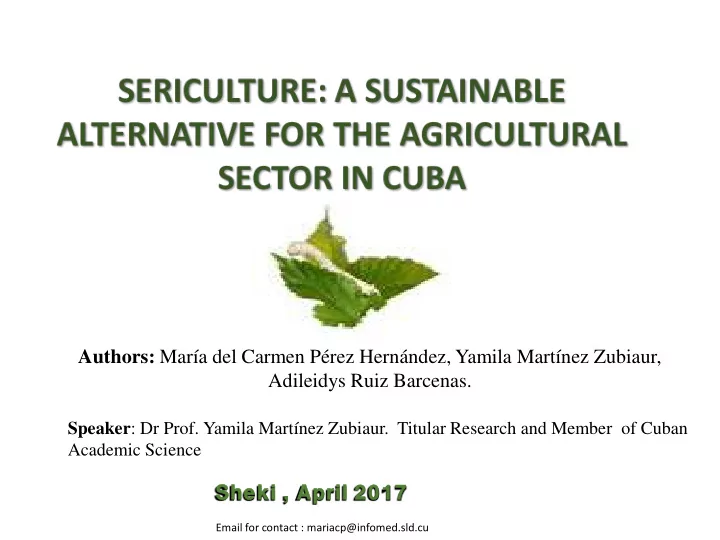

Authors: María del Carmen Pérez Hernández, Yamila Martínez Zubiaur, Adileidys Ruiz Barcenas. Speaker : Dr Prof. Yamila Martínez Zubiaur. Titular Research and Member of Cuban Academic Science Shek heki , A April il 2017 2017 Email for contact : mariacp@infomed.sld.cu
Introduction In 2011, the National Sericulture Project emerged in order to produce bioproducts for the medical-pharmaceutical, cosmetic and biotechnological industries
Three main lines are developed The mulberry ( Morus alba L .) for feeding the silkworm Silkworm rearing ( Bombyx mori ) Obtaining cocoon derivatives
The mulberry ( Morus alba L .) for feeding the silkworm
Established mulberry cultivars . The mulberry ( Morus alba L.) for silkworm feed.
Development of different methods of propagation Cutting and seed propagation 94-96% of germination At present, there are around 30 ha planted by seeds at the project’s facilities and around 390 kg of seeds have been produced for other purposes with the consequent replacement of imports.
Influence of mulberry harvest Vegetative and root development in differents cultivars . These results showed that harvesting right after 4 months of planting the plot under Cuba’s conditions (with irrigation and fertilization) did not affect vegetative and root development.
Physiological indicators C Evaluation of physiological indicators (A) foliar water potential ( Ψ f ), (B) foliar osmotic potential ( Ψ s ) and (C) stomas conductance. The highest values of water potential were attained with the Criolla or Tigreada The low levels of stomas conductance found in the Tigreada this suggest that the plant is able to make a stomas adjustment to avoid the loss of water by transpiration showing a better adaptation to low water availability, This cultivar was one of the first introduced in the country in 1996 from Costa Rica and consequently is better adapted.
Molecular characterization of mulberry ( Morus alba L.) using SSR markers ALL CULTIVARS WERE USED TO FEED THE SILKWORMS IN CUBA
Silkworm rearing ( Bombyx mori )
Evaluations of eggs from different countries Bombyx mori L. is considered an exotic organism in Cuba, it is subjected to biosecurity regulations. Eggs origin studied : Colombia, Brazil, Spain, Italy, India, Bulgaria, China (Liangguang 2), Korea and Thailand (Chul Thai 1, Chul Thai 6, Chul Thai 7). The best origin were : these breeds showed a shorter rearing cycle under Cuba’s environmental conditions, from 21-28 days to 21-23 days , which makes possible to develop up to 9 rearing per year.
Establishment and broad of facilities for silkworm rearing. “Adapted houses” with rearing capacity “The Tunnels” with a rearing for 10 boxes. Currently used for young capacity for 40 boxes in 9 silkworms. cycles.
Detection and management of diseases BmNPV is the main diseases that affect the silkworm rearing. Diagnostic protocols were established by PCR and molecular hybridization that allowed detecting the disease from the 3 rd instars.
Obtaining cocoon derivatives
Evaluation of the coccon quality according to standards parameter This is a “quality plus” value proving that under Cuba’s climatic conditions and with the rearing technology used, there is a potential to develop and produce high quality silk.
Applications derived from the silkworm cocoon Obtaining and evaluation of Silk protein hydrolyzed The product obtained showed quality according to • requirement to cosmetic industry when it was compared to Hidrosilk (imported product). The stability and toxicity assays confirmed its stability • at temperatures below 30 ͦo C, for more than 1 year. This product classifies as no skin and eye irritant.
The results allowed establishing a scheme to assume large scale sericulture on scientific foundations and methodologies that guarantee its sustainability.
Projections
Recommend
More recommend